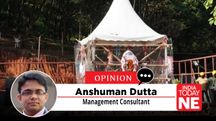I Saw Assam’s CM Sign the MoU: The Vrindavani Vastra Returns. Not Forever. But Symbolically Enough?
Instead, it was a not-so-formal meeting between Assam’s Chief Minister, Himanta Biswa Sarma, and the British Museum authorities to sign a Memorandum of Understanding that would allow the Vrindavani Vastra - one of Assam’s most cherished cultural treasures - to travel home on loan in 2027.

On 17 November in London, an event of significance took shape inside the British Museum. It was not a grand state ceremony, nor a diplomatic gathering. Instead, it was a not-so-formal meeting between Assam’s Chief Minister, Himanta Biswa Sarma, and the British Museum authorities to sign a Memorandum of Understanding that would allow the Vrindavani Vastra - one of Assam’s most cherished cultural treasures - to travel home on loan in 2027.
I attended the event too, alongside other members of the Assamese diaspora. After all, moments like this can really feel once-in-a-lifetime. The gathering didn’t include only Assamese people - there were members of other Indian diasporas as well. A few international visitors to the museum even asked the Chief Minister for selfies. Everyone smiled, including the CM, as they took pictures. Some visitors were curious, wanting to know more about the chief guest and the occasion.
The Chief Minister arrived at the museum around 1 pm UK time, which is 6:30 pm in India, roughly an hour before the ceremony. Richard Blurton, the retired curator who had worked with the Vrindavani Vastra for decades, guided him through the museum’s Indian collection, known as the Amaravati gallery. Blurton’s long experience with the artefact was evident in the way he led the tour. In fact, the tour lasted longer than the ceremony that followed. There were light moments and friendly conversations along the way, and the group took many photographs with the Chief Minister.
Then everyone entered the British Museum’s formal event hall - a bright, spacious room defined by the museum’s characteristic neoclassical style. The ceiling rose high above, giving the space an open, almost airy feel. Large windows and soft interior lighting made the room feel both official and welcoming.
Along with the Chief Minister were the Indian High Commissioner to the UK, Mr. Vikram Doraiswami; Assam Government advisor for strategy, action planning, project formulation and investment initiation, Ranjit Borthakur; and officials from the British Museum.
The ceremony began with a speech by the Chief Minister, in which he spoke about the importance of the day and how historic the moment felt. This was followed by the signing of the MoU by both parties, a careful checking of the pages, and then a handshake. The Chief Minister presented the British Museum officials with Assamese gamosas, a book on Maa Kamakhya, and a beautifully wrapped gift of Assam tea. He then addressed the media, explaining how each time he had visited London and seen the Vrindavani Vastra, he felt a deep, almost personal desire for the people of Assam to witness this historic 16th-century textile.
The Vrindavani Vastra truly deserves such longing. Created in the 16th century under the influence of Srimanta Sankardev and woven by his disciples, it is a masterpiece of silk and dye - a woven narration of Krishna’s life in Vrindavan. It carries theological depth, artistic brilliance, and the imprint of a culture that flourished in Assam long before the idea of the modern state existed. That this textile has spent more than a century abroad - travelling through Bhutan and Tibet before eventually entering the British Museum’s collection after a British journalist came across it in Delhi - adds another layer of complexity to its story. Objects may travel, but the meanings they hold remain rooted in the people they leave behind.
This MoU represents an attempt to close that distance, even if only temporarily. And like all attempts of this kind, it comes with both hope and caution.
There is, of course, a sense of pride in reclaiming something so deeply tied to Assam’s heritage - even if the Vastra is not returning permanently, but only on loan. In a world where museums often hold objects taken from former colonies, even a temporary return can feel like a symbolic victory. For many Assamese people, seeing the Vastra displayed in the new museum planned for Guwahati will be an emotional moment, a kind of homecoming. The state’s commitment to building a museum of international standards in Khanapara, with support from the JSW Group, signals an effort to act as a responsible custodian of this treasured piece of history.
There is another point that emerges. With elections approaching in Assam, the Chief Minister has tried to project the image of a leader who not only manages governance but also recognises the importance of symbolic milestones. In that sense, the return of the Vrindavani Vastra aligns naturally with the broader story he has been shaping. It allows him to appear as a guardian of Assamese identity, someone capable of engaging with international institutions and securing something that carries cultural meaning. Supporters may see this as a genuine achievement, while others might view the timing with caution, wondering whether it also serves a strategic purpose. Both readings can coexist, yet the achievement itself remains meaningful. And it is worth remembering that symbolism has power; people often respond to cultural gestures more deeply than to policy announcements.
Yet, the challenges must be acknowledged. A loan is still a loan. The terms set by the British Museum are stringent: the textile requires world-class conservation conditions. Climate control, protection from light, security, handling - these are not minor details but essential for preserving fragile history. When the Vrindavani Vastra arrived at the British Museum in 1904, the textile was already damaged. The museum’s team used various techniques and careful, in-depth conservation work to restore it and give it new life. Assam must not only build the promised museum but also maintain it, staff it with trained experts and commit to long-term care.
There is also the question of public expectation. Waiting until 2027 may test patience, and any delay in construction or preparation could invite criticism. The museum, once built, must not become a showpiece visited once during inauguration and then forgotten.
Some may ask whether such efforts distract from more immediate issues in Assam, such as unemployment or floods.That question is valid, but perhaps incomplete. A society does not survive on rice alone. It needs stories, symbols and reminders of its own craftsmanship. Culture gives people a framework to understand who they are.
In the end, the scene inside the British Museum on 17 November showed how a piece of cloth, centuries old can bridge continents and histories. The real success of this moment will not be measured today, nor even in 2027 when the Vrindavani Vastra is displayed in Assam. It will be measured in the conversations it sparks, and in the collective pride surrounding a marvellous piece of textile that originated in Assam.
Note: The author is a Chartered Marketer, writer and contributor to newspapers and magazines covering Britain-India relations.
Copyright©2025 Living Media India Limited. For reprint rights: Syndications Today









